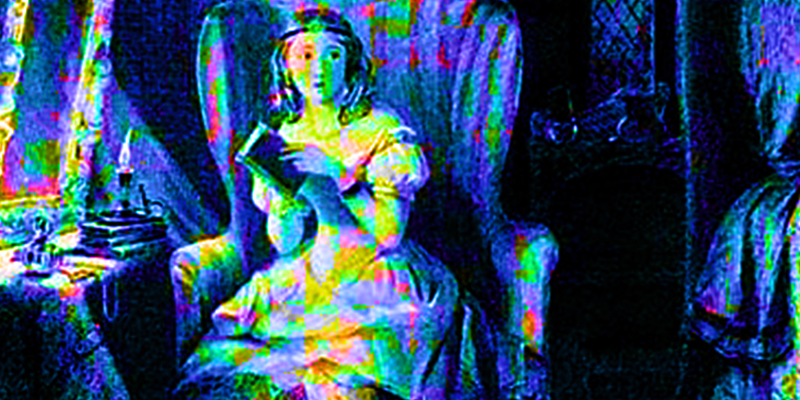Ask a casual reader what springs to mind when they think of Jane Austen, and you’ll likely hear some combination of Mr. Darcy and balls and comedy of manners. And these are, of course, all part of Austen’s enduring appeal (over 200 years and counting!)—but if you dig a little bit deeper into her oeuvre, you’ll stumble upon the curiosity that is Northanger Abbey. This occupies a strange place in her bibliography: it was actually written before all of her other published works, but only published posthumously (in a set, along with Persuasion). Once you’ve read the book, you’ll likely understand why: it’s a bit different from her others, in that while it is, ultimately, a comedic romance that sees a young lady eventually settle down with the upstanding gentleman who deserves her, it’s also—delightfully!—a satire.
Austen was writing in the heyday of Gothic novels; a modern reader’s mind might think of the Bronte sisters when they consider Gothics, but this was an earlier era, when the works of authors like Ann Radcliffe were wildly popular. Radcliffe’s novels are perfect examples of the hallmarks of Gothic fiction, featuring spooky atmospheres, a creeping feeling of unease, and oftentimes an eerie castle or estate as a setting; her works also resolutely center women as the heroines, set firmly against male villains. Radcliffe’s most famous book, The Mysteries of Udolpho, was a runaway bestseller, and it is within this context that we meet Cathine Morland, Northanger Abbey’s Gothic-novel-reading heroine. The success of Austen’s book as a satire is dependent upon readers’ familiarity with the tropes of the genre that Austen was parodying—one which, at the time, was an enormous cultural force.
My own relationship with Northanger Abbey began at a young age; in my early teens, I methodically worked my way through Austen’s entire, all-too-short backlist. My copy of Northanger Abbey was in a combined set, along with Austen’s unfinished works (The Watsons and Sanditon), and this volume was saved for last, after I’d finished her more popular books. To a fourteen-year-old in South Florida with no knowledge of the nineteenth century fervor for Gothic novels—I doubt I’d ever even heard the phrase before—the book was a bit of a peculiarity. It commenced as so many other Austen works do—with a heroine in somewhat reduced financial straits hoping to make a match—but quickly pivoted to something different.
Catherine befriends the Tilney family, whom she meets in Bath, and there is an evident spark between her and Henry Tilney, the son of the family. She is eventually invited to stay a few weeks at their estate, Northanger Abbey. Catherine—being an avid novel-reader—expects the house to be eerie and full of supernatural occurrences, and is disappointed upon her arrival to find the house instead distressingly ordinary. Soon, however, she learns of a shut-up suite of rooms that belonged to Mrs. Tilney, who died some years ago, and her overactive imagination convinces her that General Tilney either murdered her wife, or has confined her to her rooms.
Needless to say, these fears amount to nothing, and this conviction on Catherine’s part causes a wedge to form between herself and Henry, who is upset to realize she suspected his father of something so nefarious. This is an Austen novel, so of course the two young lovers are happily reconciled by the book’s end, though not before General Tilney—while not a murderer—proves to be a rather everyday sort of Austen villain: one who kicks a young lady out of his house upon learning she is not the great heiress he had suspected her to be. He eventually accepts the match, however, and Catherine and Henry are permitted to marry.
Reading this book as a teen, without an understanding of the Gothic novels that Austen was referencing, I found Northanger Abbey a strange outlier among Austen’s other work; it had the same general structure as her other novels, and ended with the outcome I’d expected, but the middle section of the book, in which the heroine becomes a victim of her own imagination, struck me as decidedly odd. It is only in reading the book as an adult—a reader and, now, a writer with a fondness of my own for gently parodying genre tropes—that I fully appreciate the arc of Northanger Abbey’s narrative. Austen’s book is not just an example of gentle satire—it illustrates the potential of genre fiction, and all of its tropes and expectations, to be a source of humor.
Genre is a useful tool—for authors, in terms of constructing the structure, plot, and emotional arc of their books; and for readers, in terms of managing their own expectations based on their knowledge of the beats of a given genre. But Northanger Abbey illustrates the further potential of genre: to allow for comedy. From the novel’s opening pages, Austen pokes gentle fun at reader expectations: Catherine is a rather ordinary-looking girl from a middle class family—an intentional contrast to the dramatic beauties so often found in the pages of Gothic novels. Upon arriving at Northanger Abbey, Catherine’s conviction that a perfectly normal country estate owned by a perfectly normal family is actually a scene of some sort of secret, disturbing crime would seem strange to a reader unfamiliar with the tropes of Gothic novels; to readers in the know, however, there’s a delicious tension between their understanding of what Catherine thinks is happening, and their knowledge of what is likely the truth instead.
It makes for a joyful reading experience; I revisited Northanger Abbey for the first time in a number of years last spring, after finishing a draft of my own gentle spoof of a Gothic romance, and I was pleasantly surprised to be reminded how skillfully Austen navigates the expectations of a Gothic novel for her own comedic purposes. And a particular source of joy—for me, at least—was the fact that the genre being satirized is not one known for its humor. As a reader, I’m unlikely to spend much of my precious reading time with Gothics; I like them in moderation, but I prefer my reading light and humorous. But what I certainly have time for is a novel that subverts my own expectations to turn a creepy, menacing genre into something funny instead, and it is this alchemy that Austen achieves in this book—an alchemy that wouldn’t be possible without the genre expectations’ existence in the first place. The success of Northanger Abbey as a comedy depends on its audience understanding the material that is being satirized—and the reassuringly predictable beats of Gothic fiction prove the perfect opportunity for such a satire.
Ultimately, what a parody provides is the opportunity for a shared joke, one predicated on a mutual understanding on the part of the audience and the creator; Austen illustrates that brilliantly within the pages of Northanger Abbey, and the fact that she finds humor from the tropes of a genre that is generally entirely lacking in it is, to me, the great fun of this book. Whenever I have mentioned, in recent months, that I’ve written a book set at a possibly-haunted country estate (To Swoon and to Spar), I’ve been the recipient of mildly puzzled looks from readers and friends who know I tend to write funny romances. Like . . . Jane Eyre? they ask hesitantly, clearly wondering if I’ve experienced a complete personality transplant, and I hasten to correct them: No, like Northanger Abbey—the ultimate proof that the creepy can be the perfect inspiration for the comedic.
***


















